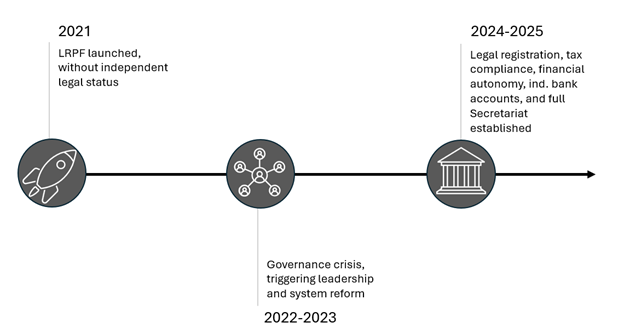Localization in Action: A New Era for Locally-Led Humanitarian Response
By: Rombek Rombek, Chairperson for The Local Response Pooled Fund South Sudan, Founder and Executive Director of Global Aim South Sudan
In this Partner Spotlight blog, the Local Response Pooled Fund (LRPF) shares key lessons learned from its journey in developing locally-led funding mechanisms in South Sudan, offering a forward-looking perspective on the road ahead for strengthening local leadership in humanitarian response.
For decades, South Sudan’s humanitarian response system has marginalized the very actors best positioned to lead it—national non-governmental organizations (NGOs). These organizations bring deep local knowledge, community trust, and local reach to deliver effective aid. Yet, they have faced major barriers, such as limited access to direct funding, exclusion from decision-making spaces, and dependency on international intermediaries.
The Local Response Pooled Fund (LRPF) was created to reverse this imbalance. But what does the journey toward locally-led funding really look like? Keep reading for practical insights into the challenges LRPF has faced and overcome —and the lessons learned along the way.
The Story Starts with a Mission
Founded in 2021 by a coalition of national NGOs, and with early support from the South Sudan NGO Forum and Save the Children, the LRPF began as a bold vision for local ownership. Today, it’s a fully registered, independent national funding mechanism that empowers South Sudanese organizations with grants, technical training, and coordination support.
From legal registration to securing tax compliance and financial independence, the road from vision to reality has been shaped by continuous change, resilience, and strategic partnerships. Just as importantly, it has required unwavering clarity of mission. At LPRF, we know that we exist to:
- Strengthen the operational capacity of national NGOs.
- Ensure direct access to donor funding.
- Promote accountability and transparency in fund management.
- Champion the localization agenda by delivering efficient, sustainable, and community-led humanitarian and development responses.
From there, the path to local ownership of our development goals has taught us valuable lessons. Here are five tips for organizations striving for locally-led funding.
What We Learned: 5 Lessons from LRPF’s Experience
- Build a Strong Governance Foundation Early. In 2022, LRPF stood at a crossroads, facing a potential collapse due to governance vulnerabilities and weak systems. Our response was swift and strategic. We adopted by-laws that were approved by over 105 member organizations, introduced a conflict-of-interest clause to eliminate internal corruption, and democratically elected a new Steering Committee. This foundation became the bedrock of our organizational revival and long-term stability.
- Secure Legal Identity and Financial Autonomy. Initially, LRPF operated without formal legal status, relying on intermediaries to work. To overcome this, we registered with the Relief and Rehabilitation Commission (RRC), opened an organizational bank account, and completed tax registration with the National Revenue Authority (NRA). These steps not only allow us to achieve financial independence but also were critical in building donor confidence.
- Invest in Operational Capacity. Nearly 95% of all of LRPF’s systems were developed from the ground up. We designed robust grant management and reporting tools, established monitoring and evaluation frameworks, and created compliance systems that ensure accountability. Our staff recruitment process was independently managed, allowing us to build a capable and mission-driven team.
- Structure for Sustainability. We focused on creating an institution that could last. Today, our Secretariat —which manages the fund’s day-to-day operations— is 99% staffed, and we’ve secured permanent office space. This has enabled smooth day-to-day management of the fund, continuous engagement with grantees, and ongoing donor communication; all essential to long-term impact.
- Let Impact Speak for Itself Ultimately, results validate our model. Between 2021 and 2024, LRPF disbursed $1.7 million to 35 national NGOs. These funds reached 50,042 individuals across eight South Sudanese states. In Eastern Equatoria, one partner —South Sudan Youth Peace and Development Organization (SSYPADO)— trained 3,500 farmers, resulting in a 35% increase in agricultural yields. In Unity State, another grantee established safe spaces for survivors of gender-based violence. These are not just statistics, they are stories of transformation led by bold local actors.
The Milestones from Vision to Reality
We’re proud of our evolution —all the way from operating under the legal auspices of a member organization to an independent and legally recognized fund with a thriving operational ecosystem.

Graph depicting the path of The Local Response Pooled Fund South Sudan
These milestones weren’t just institutional achievements, they laid the groundwork for direct donor engagement, fund transparency, and trusted partnerships.
What’s Next: The Road Ahead
As LRPF continues to mature, our goals are clear. We’re committed to expanding direct funding by engaging with donors to scale support for national organizations and reduce dependency on international agencies. We’ll also continue strengthening our governance through the ongoing refinement of accountability mechanisms that reinforce public and donor trust.
We aim to scale proven, community-led programs —such as increasing investments in climate resilience, livelihoods, and emergency response. We know our work is impossible without the support of our partners. Nurturing strong collaboration with Save the Children and strategic allies remains essential as we collectively advocate for increased localization funding.
At its core, LRPF is not just a fund —it’s living proof that South Sudanese NGOs can lead, manage, and deliver aid with transparency and impact. We’re a movement for localized humanitarian and development action, one that strives to inspire locally-led change around the world.

